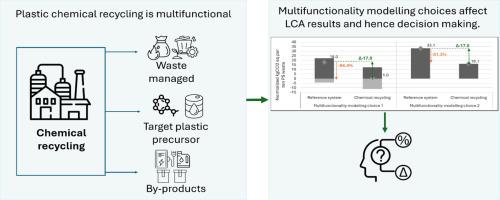LCA中的多功能模型如何影响决策:以塑料废物的化学回收为例
IF 10.9
1区 环境科学与生态学
Q1 ENGINEERING, ENVIRONMENTAL
引用次数: 0
摘要
化学回收(CR)有望关闭塑料循环,但证明其环境效益对政策和经济支持至关重要。生命周期评估(LCA)评估环境可持续性,但模型的变化,如多功能性,使决策复杂化。本研究通过考察其对LCA结果的影响,为LCA多功能建模理论做出了贡献。利用两个CR塑料废物案例研究,分析了七种建模方法,包括功能单元(产品/废物视角)、副产品多功能(替代(Sub)/产品篮子(BoP))和寿命终止(EoL)多功能(截止/循环足迹公式(CFF))。结果表明,当将CR与传统的废物管理和生产系统进行比较时,BoP和Sub的影响三角洲具有明确的边界和截止EoL。然而,潜管和防喷器的绝对结果和比较指标的差异突出了误解的风险。通过展示建模选择的影响,本研究为决策者、行业和研究人员提供了可操作的见解,增强了基于lca的明智决策。本文章由计算机程序翻译,如有差异,请以英文原文为准。

How multifunctionality modelling in LCA affects decision-making: The case of chemical recycling of plastic waste
Chemical recycling (CR) holds promise for closing the plastic loop, but demonstrating its environmental benefits is crucial for policy and economic support. Life cycle assessment (LCA) assesses environmental sustainability, yet variations in modelling, such as multifunctionality, complicate decision-making. This study contributes to LCA multifunctionality modelling theory by examining its effects on LCA outcomes. Using two CR plastic waste case studies, seven modelling approaches were analysed, varying the functional unit (product/waste perspective), co-product multifunctionality (substitution (Sub)/basket of products (BoP)), and end-of-life (EoL) multifunctionality (cut-off/circular footprint formula (CFF)). Results showed consistent impact deltas for BoP and Sub with well-defined boundaries and cut-off EoL when comparing CR's impact with conventional waste management and production systems. However, differences in absolute results and comparative metrics for Sub and BoP highlight the risk of misinterpretations. By demonstrating the influence of modelling choices, this study provides actionable insights for policymakers, industry, and researchers, enhancing informed LCA-based decision-making.
求助全文
通过发布文献求助,成功后即可免费获取论文全文。
去求助
来源期刊

Resources Conservation and Recycling
环境科学-工程:环境
CiteScore
22.90
自引率
6.10%
发文量
625
审稿时长
23 days
期刊介绍:
The journal Resources, Conservation & Recycling welcomes contributions from research, which consider sustainable management and conservation of resources. The journal prioritizes understanding the transformation processes crucial for transitioning toward more sustainable production and consumption systems. It highlights technological, economic, institutional, and policy aspects related to specific resource management practices such as conservation, recycling, and resource substitution, as well as broader strategies like improving resource productivity and restructuring production and consumption patterns.
Contributions may address regional, national, or international scales and can range from individual resources or technologies to entire sectors or systems. Authors are encouraged to explore scientific and methodological issues alongside practical, environmental, and economic implications. However, manuscripts focusing solely on laboratory experiments without discussing their broader implications will not be considered for publication in the journal.
 求助内容:
求助内容: 应助结果提醒方式:
应助结果提醒方式:


